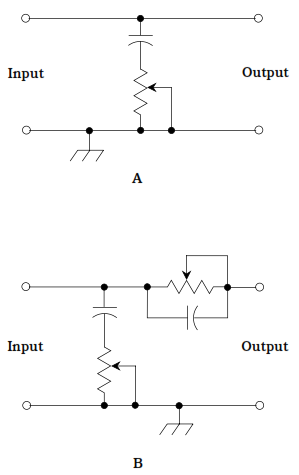Audio mixer
If you connect two or more audio sources to the same input of the amplifier, you cannot expect good results. Different signal sources are likely to have different impedances. When connected

Figure--Methods of tone control.At point A, a single potentiometer provides continuous bass-to-treble adjustment. At point B, two potentiometers allow more precise adjustment.
together, impedances are connected in parallel. This will cause impedance mismatches for most or all of sources, as well as at amplifier input. The result will be degradation of the system efficiency and resulting in poor overall performance.Another problem is that signal amplitudes from various sources which always differ, sometimes very much. The microphone produces minuscule audio-frequency currents, whereas some of the tape decks produce sufficient power to drive a pair of small loudspeakers. Connecting both of these together will cause microphone signal to be obliterated by signal from tape deck. The tape deck audio may damage the microphone, as the microphone is connected directly across the tape deck output.
An audio mixer removes both of these problems. First, it isolates the inputs from each other, so there is no impedance mismatch or competition among sources. Second, gain at each input is varied independently. This allows adjustment of the amplitudes so the signals blend in desired ratio. The microphone input gain, for instance, could be set much higher than tape-deck input gain such that the signals from both would come out at the equal intensity.
The sophisticated mixers have exotic features, like echo effects, frequency response filters, and various graphic equalizers. Some mixers have automatic level control (ALC) which can be switched in to prevent loud sound peaks from causing distortion. Some of the units have VU meters for each input and for the output in each stereo channel.